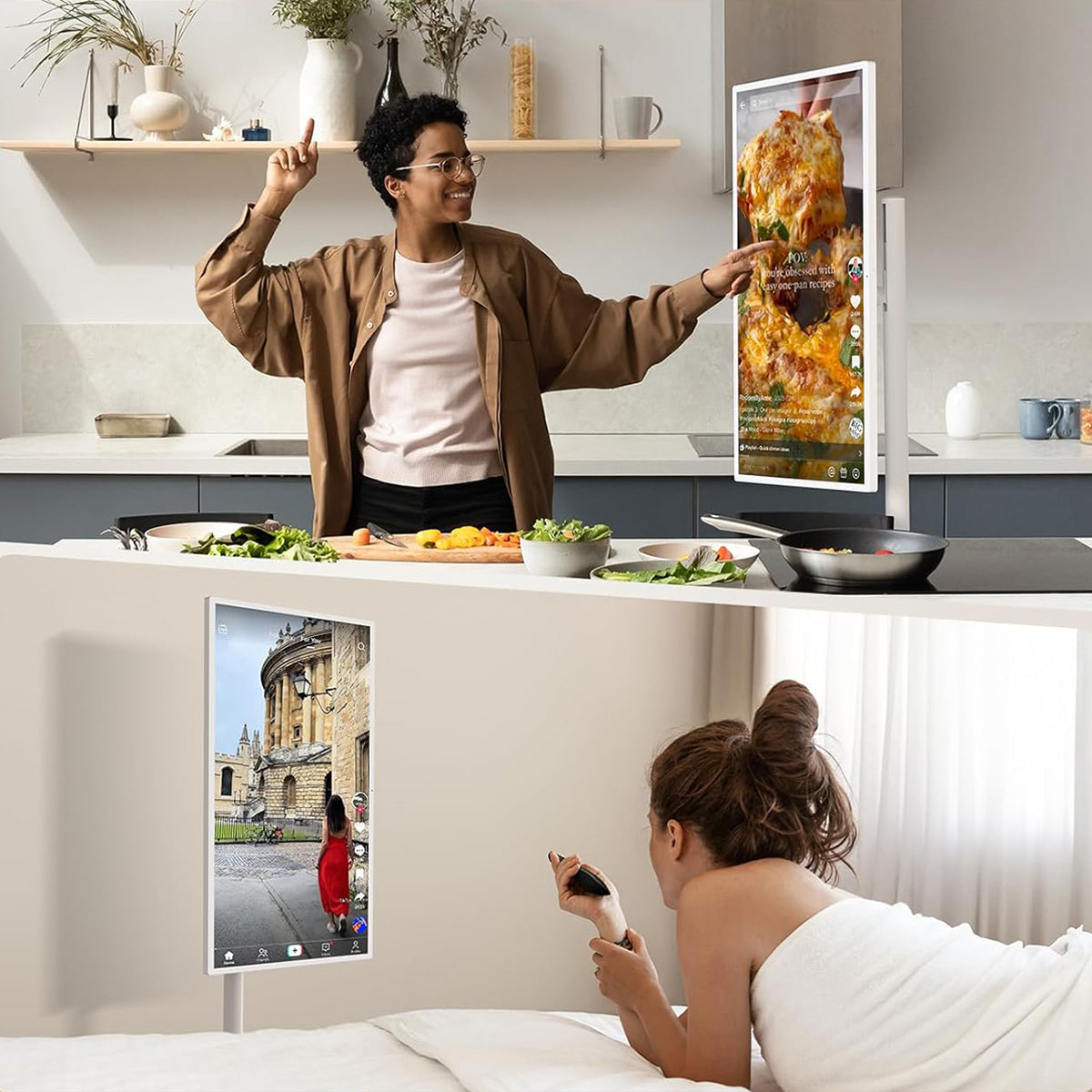Table of Contents
Television technology has transformed a lot over the past several decades. What were once mechanical knobs have shifted into intelligent, AI-powered TV Operating Systems. Each era impressed viewers with new ways. From simple channel selectors to multi-modal interfaces that respond to touch, gestures, and voice, TVs have come a long way.
According to Tech Insights, among connected TV operating systems, the adoption of smart TVs is set to soar in the next five years, creating a competitive landscape.
Do you want to jump into the depths of evolution? This blog will tell about the complete evolution of the TV control system. We will trace how innovations across the 1950s to date have reshaped convenience, entertainment, and accessibility. Concluding with how modern solutions, such as GFF Portable TV on wheels, offer a combination of advanced interaction methods and smart system design, supporting various real-world usage situations.

Mechanical Control Era (1950s–1980s)
The Beginnings of Television Control
The earliest televisions centered around simplicity and direct interaction. TVs from the 1950s through the 1980s relied solely on mechanical components. This required the users to walk to the device and manually adjust every setting. People depended on moving knobs, switches, and mechanical tuners to change channels, modify volume, or fine-tune picture quality. These units formed the first TV control system, offering a straightforward yet consistent way for people to operate their televisions.
Mechanical Interfaces and User Experience
Interestingly, rotary knobs stood out as this era’s most iconic element. Every turn generated distinct clicks. These were the sounds of the mechanical tuner’s internal movement. The knob system was regarded as efficient and perfect, as only a few channels were available at that time. Here, the interaction was tactile; every adjustment demanded an intentional physical action. As a result, the experience was predictable and intuitive for all users.
Pre-Software Television Operation
TV Operating Systems did not exist in software form during this time. Rather, the operational logic rested within analog circuits. The TV’s exterior panel served as the main interface, and every function required direct hardware manipulation. Moreover, the design offered clear benefits, such as durability, minimal repairs, and long-lasting components. But the sad part was that it also gave limited flexibility and personalization. Users were restricted to control the picture manually, adjust volume with basic settings, and do linear channel browsing.
Limitations and Wishes for Innovation
With the expansion of broadcasts and as households gained access to more channels, the mechanical controls felt restrictive. People wished for easier access, quicker navigation, and the ability to operate from a distance. The surging demand for convenience turned out to be the driving force behind the introduction of remote control technology, one of the most significant upgrades in TV history. This would forever reshape how viewers saw TV.
Infrared Remote Control Era (1980s–2000s)
A Big Leap in Television Interaction
A big leap in television interaction was seen in the 1980s. The infrared remote controls were launched. This drastic advancement changed the TV control system, allowing you to operate TVs from sitting across the room rather than standing in front of the screen.
With Infrared technology, functions like changing channels, navigating basic settings, and adjusting volume became comparatively easier. It would work when there was a clear line of sight between the TV’s sensor and the remote.
The Growth of Convenience
Quickly, IR remotes became the industry standard. Because brands also adopted the remotes due to their simplicity and user-friendly operation. Also, as cable and satellite services introduced hundreds of channels, the need for the technology grew. This era was viewed as one of the earliest steps toward modern TV Operating Systems, as users now wanted efficient ways to navigate new content options. Remote controls became an essential component of every television.
The On-Screen Displays Emerges
During the IR remote control, the on-screen displays also emerged. TVs directly started showing volume indicators, channel numbers, and basic menu options on the screen. This innovation merged hardware controls with early-stage software feedback, marking these as the first TVs that could visually communicate with users. Yes, they were simple based on today’s standards, but these screens represented the rise of more interactive interfaces.
Universal Remotes and Multi-Device Control
The remote control’s role widened as the demand for VCRs, DVD players, and home theater systems increased. Manufacturers designed universal remotes. These were capable of controlling multiple devices through IR-coded commands. This shift moved the TV control system beyond single-device functionality toward a centralized remote control to manage the entire entertainment arrangement.
Smarter Solutions Were Required
Even though IR remote controls were successful, the technology still had prominent limitations. You couldn’t navigate digital menus, button-heavy remotes were often confusing, and line-of-sight remained crucial.
As TVs became more updated and content libraries grew, users demanded smarter, intuitive control systems. This led to the next era in television interaction.
Menu-Based & Smart Remote Era (2000s–2010)
The Software-Driven TV Interfaces Rise
A major turning point happened in the early 2000s in television evolution. The first TV Operating Systems were introduced. The new televisions shifted away from the basic on-screen displays to structured digital menus. Here, viewers for the first time could access electronic program guides and adjust tailorable settings. Plus, use integrated digital tuners that were powered by software instead of simple hardware cues.
Welcoming Smart Remotes
“Smart remotes” took the advancement to the next level. These came with directional pads, menu buttons, and navigation keys. The keys were specifically crafted for interacting with complicated digital interfaces. The TV control system provided mixed hardware interactions with software logic, letting users scroll through content, tailor their viewing experience, and open menus with greater precision.
Digital Broadcasting and Early Smart Features
The growth of digital broadcasting was behind the acceleration of the requirement for more capable menu systems. The TV's smart features increased. It had to manage a list of channels, adjust aspect ratio, language preferences, and detailed signal information. This integration of computing technology on a deeper level laid the foundation for the earliest smart TV models.
Manufacturers Experimented With Connectivity
Aside from filling the TV with features, manufacturers also started to experiment with connectivity. Some TVs provided basic networking features. This enabled firmware updates or limited access to online content. You might consider them old school, but these connectivity capabilities were also the first steps toward connected entertainment.
Future Innovation’s Foundation
Consumers became used to digital menus and smarter navigation by the end of this decade. Their personalization, speed, and unified control expectations set the stage for the next era. Advanced smart remotes and multi-modal interaction defined it.
Smart Remote & Multi-Modal Interaction Era (2010–Now)
Intelligent TV Systems Enter
The evolution of TV Operating Systems accelerated from 2010 onwards at an unmatched pace. The internet-connected smart TVs transformed from a simple display device into an interactive digital hub. Modern platforms such as webOS, Android TV, and a variety of proprietary systems introduced app ecosystems. Along with AI-driven recommendations, switching content made TV experiences more tailored than ever.
Remote Control Technology’s Transformation
Not only did the Intelligent TV Systems enter, but the TV control system also experienced a major leap. The mainstream remotes got upgraded with touchpads, scrolling wheels, motion sensors, and dedicated buttons for streaming applications.
Furthermore, voice assistants like Alexa, Google Assistant, Alexa, and other AI technologies allowed full hands-free operation. This allows users to open apps, control smart home devices, or adjust settings using simple voice commands.
The Era of Multi-Modal Interaction
Television interaction was no longer limited to button presses. Multi-modal control methods sorted out that area:
- Voice Control: It allows effortless, hands-free navigation.
- Touch Control: You can control the touchscreen TVs with smart remotes.
- Gesture Control: Some selective models have gesture control.
- Mobile App Control: The mobile app control lets smartphones function as remotes.
- AI Personalization: This feature adapts content and settings according to user behavior.
When these input methods work together. You receive a fast, intuitive, and accessible interaction experience for all kinds of viewers.
Televisions as Connected Ecosystems
The good news is that the modern TV Operating Systems now support cloud sync, parental controls, device casting, and advanced picture optimization. In short, the TVs have changed into multi-purpose smart hubs, integrating with connected homes, entertainment systems, and offices.
GFF Portable TV on Wheels Operating System
A Modern Multi-Modal TV Experience
The GFF S1 Portable TV on Wheels represents a prominent advancement in terms of flexible and interactive televisions. It is designed to be moved outdoors and indoors and integrates three powerful control methods to use in multiple scenarios.. Therefore, you can take it to classrooms, retail environments, and offices.

Three Control Methods
The first one is a responsive touchscreen interface, ideal for presentations, learning activities, and applications, requiring direct interaction. Second is the smart remote control, giving familiar yet improved navigation for daily viewing. The last is mobile app control. This turns smartphones into excellent extensions of the TV control system.
Powered by Intelligent TV Software
The advanced TV Operating Systems support these capabilities. Due to which you receive smooth performance, personalized user settings, and quick app switching. The GFF S1 quickly adapts to user needs with Android-based intelligence and full multi-modal support.
Conclusion
We have come to the end of the evolution of TV Operating Systems. If you are interested in purchasing the TV control system moving on wheels, buy the GFF S1.
About the Author:
Nana Xu is a tech writer and product enthusiast who focuses on smart home devices and innovative display technologies. With a passion for user-friendly design and new trends in consumer electronics, she helps readers make smarter choices for modern living.





